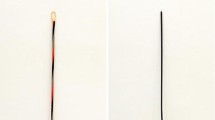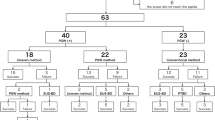Abstract
Background
In duodenoscopy, during endoscopic retrograde cholangiopancreatography (ERCP), a backward-oblique angle duodenoscope (BOAD) is generally used. In Japan, 15° BOAD are mainly used, but in Western countries, 5° BOAD are mostly used. In bile duct cannulation associated with ERCP, a catheter for contrast imaging is used in Japan, but wire-guided cannulation (WGC) using a papillotome is standard in Western countries. We conducted a randomized controlled multicenter trial to evaluate the contributions of different duodenoscopes using WGC to selective common bile duct cannulation.
Methods
Subjects comprised 179 consecutive patients who underwent ERCP. Patients were randomized into the 15° BOAD group (15° group, n = 90) or the 5° BOAD group (5° group, n = 89).
Results
The duodenal papilla could not be accessed endoscopically in two cases from each group. Success rates for bile duct cannulation by WGC without bow-up for the 15° and 5° groups were 85.6 and 56.2%, respectively (P < 0.01). Success rates for bile duct cannulation by WGC with bow-up for the 15° and 5° groups were 88.9 and 78.7%, respectively. Total rates of bile duct cannulation for the 15° and 5° groups were 94.4 and 92.1%, respectively. As for accidents, incidences of acute pancreatitis for the 15° and 5° groups were 5.6 and 9.0%, respectively, with no significant difference seen.
Conclusions
With 15° BOAD, bile duct cannulation was favorable without papillotome bow-up. With 5° BOAD, the success rate of WGC may be improved by adjusting the angle based on papillotome bow-up.



Similar content being viewed by others
Abbreviations
- ERCP:
-
Endoscopic retrograde cholangiopancreatography
- BOAD:
-
Backward-oblique angle duodenoscope
- WGC:
-
Wire-guided cannulation
- ITT:
-
Intention-to-treat
- PP:
-
Per protocol
- CBD:
-
Common bile duct
References
Lella F, Bagnolo F, Colombo E, Bonassi U. A simple way of avoiding post-ERCP pancreatitis. Gastrointest Endosc. 2004;59:830–4.
Artifon EL, Sakai P, Cunha JE, Halwan B, Ishioka S, Kumar A. Wire-guided cannulation reduces risk of post-ERCP pancreatitis and facilitates bile duct cannulation. Am J Gastroenterol. 2007;102:2147–53.
Bailey AA, Bourke MJ, Williams SJ, Walsh PR, Murray MA, Lee EY, et al. A prospective randomized trial of cannulation technique in ERCP: effects on technical success and post-ERCP pancreatitis. Endoscopy. 2008;40:296–301.
Katsinelos P, Paroutoglou G, Kountouras JA, Chatzimavroudis G, Zavos C, Pilpilidis I, et al. A comparative study of standard ERCP catheter and hydrophilic guidewire in the selective cannulation of the common bile duct. Endoscopy. 2008;40:302–7.
Lee TH, Park DH, Park JY, Kim EO, Lee YS, Park JH, et al. Can wire-guided cannulation prevent post-ERCP pancreatitis? A prospective randomized trial. Gastrointest Endosc. 2009;69:444–9.
Mayedo A, Borkar D. Techniques of selective cannulation and sphincterotomy. Endoscopy. 2003;35:S19–23.
Cotton PB, Lehman G, Vennes J, Geenen JE, Russell RC, Meyers WC, et al. Endoscopic sphincterotomy complications and their management: an attempt at consensus. Gastrointest Endosc. 1991;37:383–93.
Acknowledgments
We express our deepest appreciation to the members of the Hokkaido Pancreaticobiliary-Study Group (HPSG) and to their institutions. For full details, please see the Appendix.
Conflict of interest statement
We declare that we have no conflict of interest.
Author information
Authors and Affiliations
Corresponding author
Additional information
All authors are members of the Hokkaido Pancreaticobiliary-Study Group (HPSG). See Appendix.
Appendix
Appendix
Hokkaido Pancreaticobiliary-Study Group (HPSG) consists of Hiroshi Kawakami. MD, Masaki Kuwatani. MD, Kazunori Etoh. MD, Shin Haba. MD, Manabu Onodera. MD, Hokkaido University Hospital (Department of Gastroenterology), Hiroyuki Maguchi. MD, Kuniyuki Takahashi. MD, Akio Katanuma. MD, Manabu Osanai. MD, Teine-Keijinkai Hospital (Center for Gastroenterology), Tsuyoshi Hayashi. MD, Hirotoshi Ishiwatari. MD, Sapporo Medical University School of Medicine (Department of 4th Internal Medicine), Nobuyuki Yanagawa. MD, Asahikawa Kosei Hospital (Department of Gastroenterology), Atsushi Chiba. MD, Kazuya Koizumi. MD, Asahikawa City Hospital (Department of Internal Medicine), Hiroyuki Hisai. MD, Japan Red Cross Date General Hospital (Department of Gastroenterology), and Hisato Amizuka. MD, Sapporo Higashi Tokushukai Hospital (Department of Gastroenterology).
Rights and permissions
About this article
Cite this article
Kawakami, H., Maguchi, H., Hayashi, T. et al. A prospective randomized controlled multicenter trial of duodenoscopes with 5° and 15° backward-oblique angle using wire-guided cannulation: effects on selective cannulation of the common bile duct in endoscopic retrograde cholangiopancreatography. J Gastroenterol 44, 1140–1146 (2009). https://doi.org/10.1007/s00535-009-0107-x
Received:
Accepted:
Published:
Issue Date:
DOI: https://doi.org/10.1007/s00535-009-0107-x




